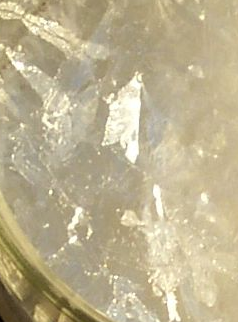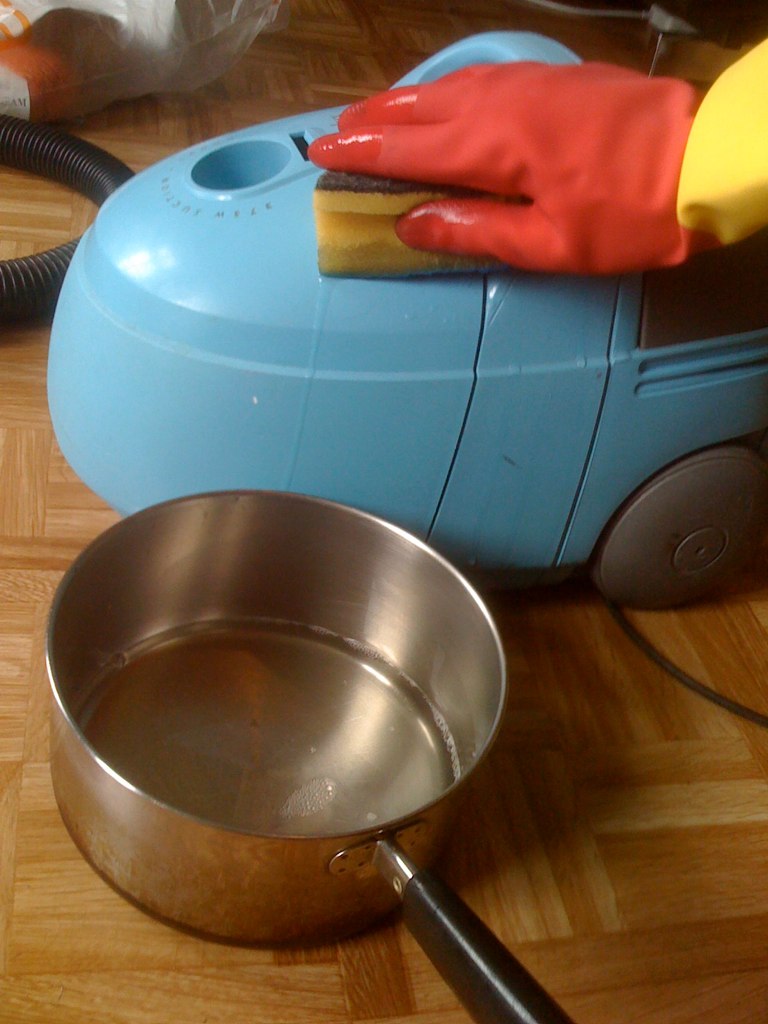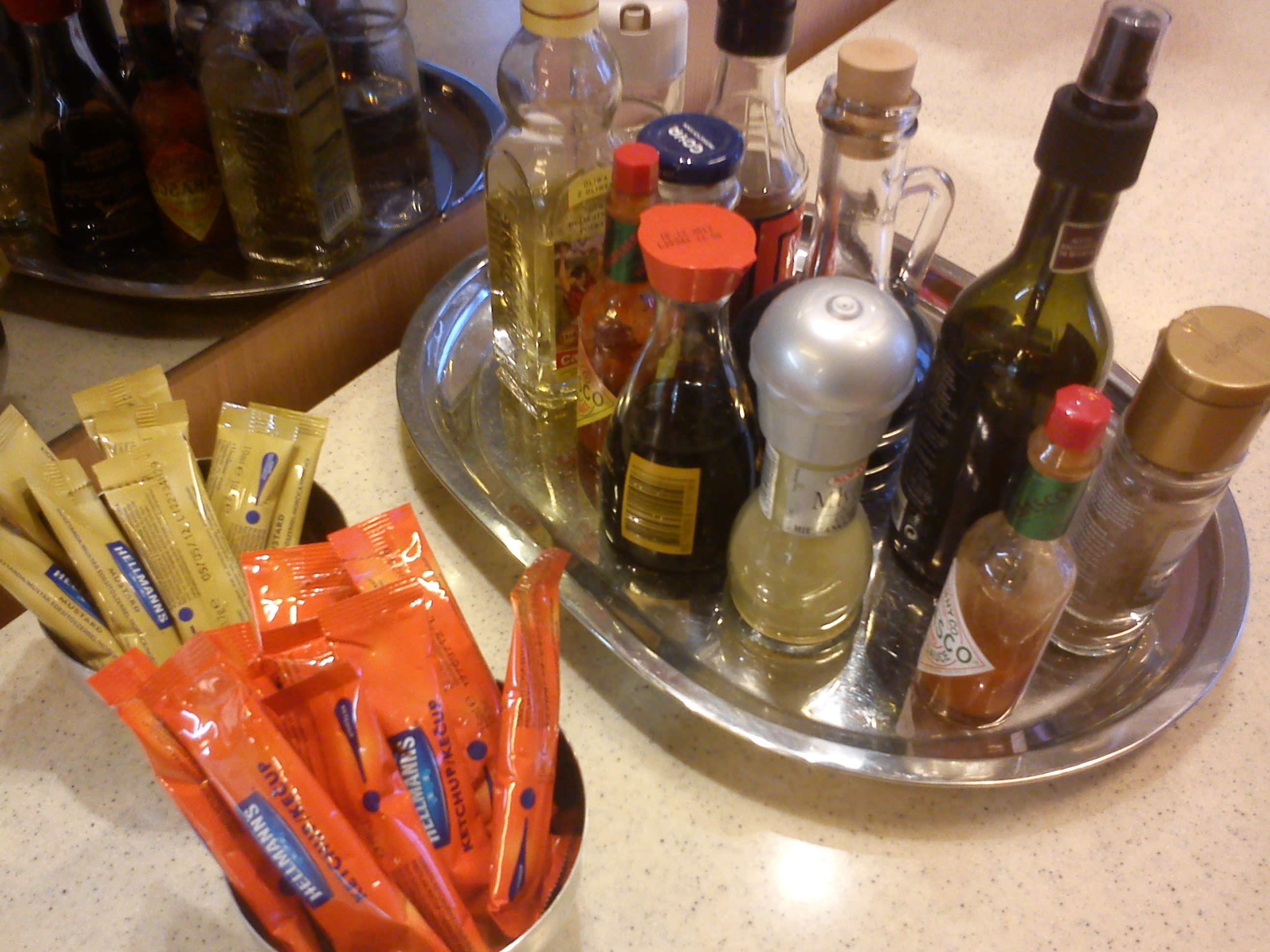|
Vinegar
Vinegar is an aqueous solution of acetic acid and trace compounds that may include flavorings. Vinegar typically contains 5–8% acetic acid by volume. Usually, the acetic acid is produced by a double fermentation, converting simple sugars to ethanol using yeast, and ethanol to acetic acid by acetic acid bacteria. Many types of vinegar are available, depending on source materials. It is now mainly used in the culinary arts as a flavorful, acidic cooking ingredient, or in pickling. Various types are used as condiments or garnishes, including balsamic vinegar and malt vinegar. As the most easily manufactured mild acid, it has a wide variety of industrial and domestic uses, including use as a household cleaner. Etymology The word "vinegar" arrived in Middle English from Old French (''vyn egre''; sour wine), which in turn derives from Latin: ''vinum'' (wine) + ''acer'' (sour). Chemistry The conversion of ethanol (CH3CH2OH) and oxygen (O2) to acetic acid (CH3COOH) takes ... [...More Info...] [...Related Items...] OR: [Wikipedia] [Google] [Baidu] |
Balsamic Vinegar
Balsamic vinegar ( it, aceto balsamico) is a very dark, concentrated and intensely flavoured vinegar originating in Modena, Italy, made wholly or partially from grape must: freshly crushed grape juice with all the skins, seeds and stems. The term ''aceto balsamico'' is unregulated, but there are three protected balsamic vinegars: ''Aceto Balsamico Tradizionale di Modena DOP'' ( Traditional Balsamic Vinegar of Modena), ''Aceto Balsamico Tradizionale di Reggio Emilia DOP'' ( Traditional Balsamic Vinegar of Reggio Emilia), and ''Aceto Balsamico di Modena IGP'' ( Balsamic Vinegar of Modena). The two traditional balsamic vinegars are made the same way from reduced grape must aged for several years in a series of wooden barrels, and are produced exclusively in either the province of Modena or Reggio Emilia. The names of these two vinegars are protected by the European Union's Protected Designation of Origin, while the usually less expensive Balsamic Vinegar of Modena (''Aceto Bal ... [...More Info...] [...Related Items...] OR: [Wikipedia] [Google] [Baidu] |
Acetic Acid
Acetic acid , systematically named ethanoic acid , is an acidic, colourless liquid and organic compound with the chemical formula (also written as , , or ). Vinegar is at least 4% acetic acid by volume, making acetic acid the main component of vinegar apart from water and other trace elements. Acetic acid is the second simplest carboxylic acid (after formic acid). It is an important chemical reagent and industrial chemical, used primarily in the production of cellulose acetate for photographic film, polyvinyl acetate for wood glue, and synthetic fibres and fabrics. In households, diluted acetic acid is often used in descaling agents. In the food industry, acetic acid is controlled by the food additive code E260 as an acidity regulator and as a condiment. In biochemistry, the acetyl group, derived from acetic acid, is fundamental to all forms of life. When bound to coenzyme A, it is central to the metabolism of carbohydrates and fats. The global demand for aceti ... [...More Info...] [...Related Items...] OR: [Wikipedia] [Google] [Baidu] |
Pickling
Pickling is the process of food preservation, preserving or extending the shelf life of food by either Anaerobic organism, anaerobic fermentation (food), fermentation in brine or immersion in vinegar. The pickling procedure typically affects the food's texture and flavor. The resulting food is called a ''pickle'', or, to prevent ambiguity, prefaced with ''pickled''. Foods that are pickled include vegetables, fruits, meats, fish, dairy and eggs. Pickling solutions that are typically highly acidic, with a pH of 4.6 or lower, and high in salt, prevent enzymes from working and micro-organisms from multiplying. Pickling can preserve Decomposition, perishable foods for months. Antimicrobial herbs and spices, such as mustard seed, garlic, cinnamon or cloves, are often added. If the food contains sufficient moisture, a pickling brine may be produced simply by adding dry salt. For example, sauerkraut and Korean kimchi are produced by salting the vegetables to draw out excess water. Natur ... [...More Info...] [...Related Items...] OR: [Wikipedia] [Google] [Baidu] |
Cleaning Agent
Cleaning agents or hard-surface cleaners are substances (usually liquids, powders, sprays, or granules) used to remove dirt, including dust, stains, bad smells, and clutter on surfaces. Purposes of cleaning agents include health, beauty, removing offensive odor, and avoiding the spread of dirt and contaminants to oneself and others. Some cleaning agents can kill bacteria (e.g. door handle bacteria, as well as bacteria on worktops and other metallic surfaces) and clean at the same time. Others, called degreasers, contain organic solvents to help dissolve oils and fats. Chemical agents Acidic Acidic cleaning agents are mainly used for removal of inorganic deposits like scaling. The active ingredients are normally strong mineral acids and chelants. Often, surfactants and corrosion inhibitors are added to the acid. Hydrochloric acid is a common mineral acid typically used for concrete. Vinegar can also be used to clean hard surfaces and remove calcium deposits that also ... [...More Info...] [...Related Items...] OR: [Wikipedia] [Google] [Baidu] |
Acetic Acid Bacteria
Acetic acid bacteria (AAB) are a group of Gram-negative bacteria which oxidize sugars or ethanol and produce acetic acid during fermentation. The acetic acid bacteria consist of 10 genera in the family Acetobacteraceae. Several species of acetic acid bacteria are used in industry for production of certain foods and chemicals. Description All acetic acid bacteria are rod-shaped and obligate aerobes. Acetic acid bacteria are airborne and are ubiquitous in nature. They are actively present in environments where ethanol is being formed as a product of the fermentation of sugars. They can be isolated from the nectar of flowers and from damaged fruit. Other good sources are fresh apple cider and unpasteurized beer that has not been filter sterilized. In these liquids, they grow as a surface film due to their aerobic nature and active motility. Fruit flies or vinegar eels are considered common vectors in the propagation of acetic acid bacteria. The growth of ''Acetobacter'' in ... [...More Info...] [...Related Items...] OR: [Wikipedia] [Google] [Baidu] |
Condiment A condiment is a preparation that is added to food, typically after cooking, to impart a specific flavor, to enhance the flavor, or to complement the d |




